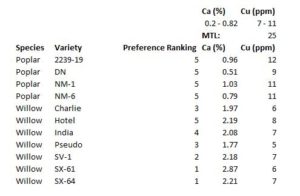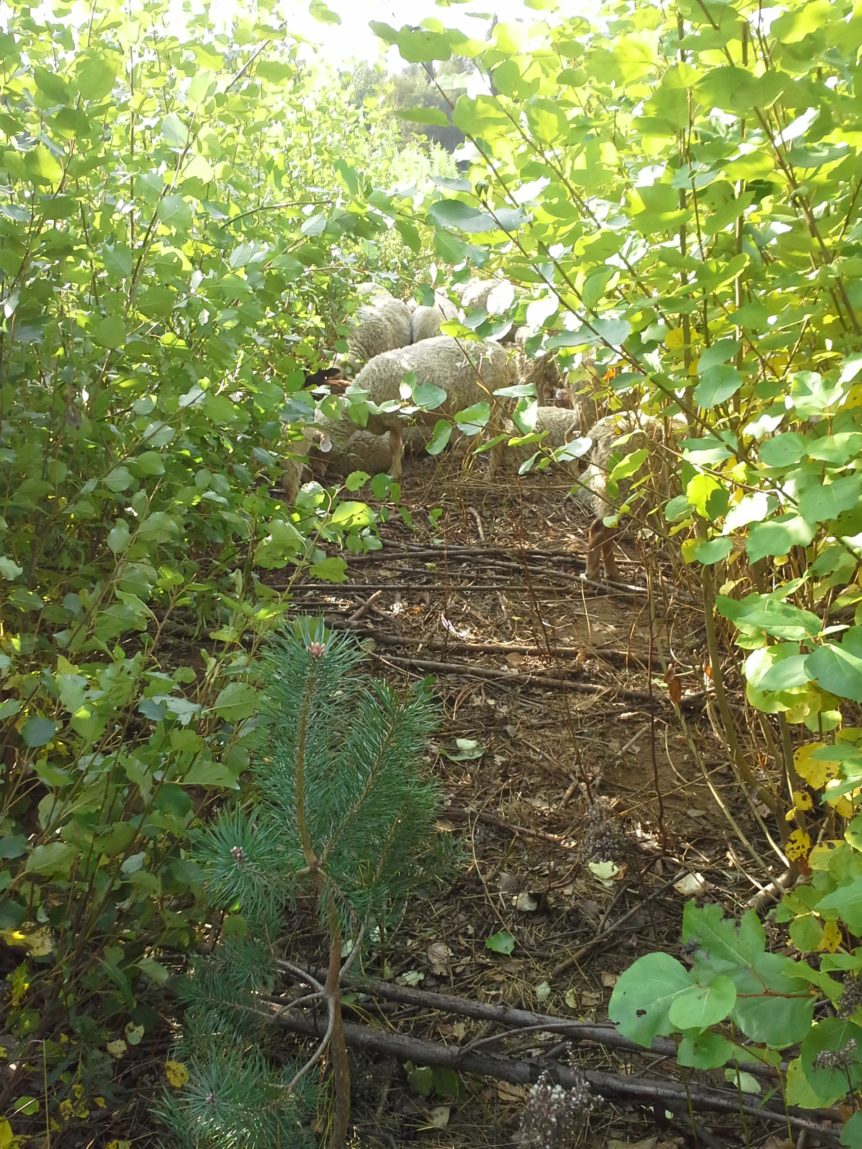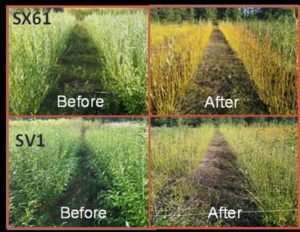This research note is part of a series detailing results from different facets of the trial. For more information, see:
Fodder Trees: 2015 Yield and Nutrient Analysis
2015 Sheep Production Report on Fodder Tree Diet
Economic Analysis and Practical Applications of Fodder Trees
RAIN has partnered with the Ontario Sheep Marketing Agency to investigate whether fast-growing, coppiced trees can be a nutritionally and economically viable fodder source for sheep. This project is taking place over the 2015 and 2016 growing seasons near Sault Ste Marie.
Method
In 2007, a short rotation woody coppice plantation was established by the Canadian Forest Service to assess the potential of fast growing willow and poplar for bioenergy. A section of this plantation was fenced off and split into four 0.75 acre paddocks. Trees were cut to 4” and allowed to regrow to heights of 12-24” before sixty mature, dry, Arcott Outaouais ewes rotationally grazed the new re-growth. Sheep were monitored to determine if any preferences for different tree species/varieties existed. Samples of the new growth were taken to determine dry matter yields and nutrient content of the tree re-growth.
Results
Sheep Preferences
Specific variety preferences were clear; the first species consumed were willow varieties SX-61 and SX-64, sharing similar genetics, qualities and yield. Secondly, sheep preferred to eat willow variety SV-1, then variety Charlie and Pseudo (these last two are tree-type willow varieties rather than shrub-type). Willow variety India was partially consumed and variety Hotel was completely avoided. Hybrid poplar varieties were also avoided, but sheep were witnessed consuming leaves on occasion. Utilization of preferred tree species was 100%.
Click photo to enlarge
Domestic tree varieties were ranked 1-5 based on the information above, with 1 being the most preferred. When this data was correlated with the data on nutrients that showed statistically significant differences between domestic tree types, it suggests that sheep were selecting for varieties with higher calcium, and were selecting against varieties with higher copper content.
Ewes requiring a maintenance diet (i.e.: not breeding, in later stages of pregnancy, or lactating) need calcium at 0.2% of their total diet in order to maintain their skeletal system. All leaf samples exceeded this requirement, so it is unlikely that their selection preferences were motivated by calcium content.

Table 1. Sheep preference ranking and nutrient contents – calcium (Ca) and copper (Cu) – with statistically significant correlations
Click table to enlarge
Sheep are more likely than any other domestic animal to develop chronic copper poisoning (CCP). Normal plant levels of copper are between 10 and 20 ppm (the tree leaves in this trial were between 5 – 12 ppm). Molybdenum plays a critical role in limiting copper uptake in sheep and preventing toxicity; sheep require at least 0.5 ppm molybdenum in their diet. None of the trees contained more than 0.35 ppm molybdenum. Soil sulphur levels influence molybdenum availability; high levels of sulphur tie up molybdenum and prevent it from regulating copper absorption. The soils on this site had very high sulphur levels, at 19 ppm. Because there may be a nutritional motive for sheep to select against copper content, the Rural Agri-Innovation Network (RAIN) is consulting a sheep nutritionist to determine if there is any evidence that sheep express copper avoidance.
Thanks to our farmer cooperators Brent Attwell and Colleen Alloi for their assistance with this project.



Comments 2
Pingback: Rural Agri-Innovation Network (RAIN) - 2015 Sheep Production Report on Fodder Tree Diet | Rural Agri-Innovation Network (RAIN)
Pingback: Rural Agri-Innovation Network (RAIN) - Fodder Trees: 2015 Yield and Nutrient Analysis | Rural Agri-Innovation Network (RAIN)